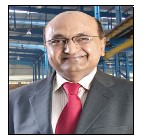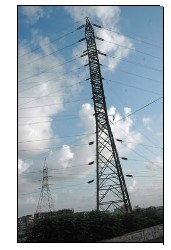 — Pravin Agarwal, Whole-time Director,
Sterlite Technologies Ltd
Sterlite Technologies
— Pravin Agarwal, Whole-time Director,
Sterlite Technologies Ltd
Sterlite Technologies Ltd, the world's largest manufacturer of power
conductors, is now emerging as a leading developer of
transmission lines with three inter-regional schemes in its fold.
Pravin Agarwal takes us through STL's evolution as a power
transmission provider and feels strongly about extending the public
private partnership philosophy to this sector. The increasing role of
private sector players will have a very positive bearing on India's
power transmission sector where huge deficits exist. An interview
by
Venugopal Pillai.
With all inter-regional power transmission lines now being
awarded under the tariff-based competitive bidding method
(effective January 5, 2011), how do you see the way forward for
private sector participation?
Power Transmission was mostly in the hands of the Central
Utility - Power Grid Corporation of India Ltd (PGCIL) and as of
January 5, 2011 all transmission projects would go through
competitive bidding under the BOO model.
We see this as a very positive development for the country
because transmission as a sector has long been overlooked and
the deficit in transmission is far greater than that in generation.
Therefore private investment is the need of the hour. Moreover
this sector has been largely inefficient so far due to "costplus"
model. Such a model de-incentivizes the transco from optimizing
costs; and therefore with arrival of private participation it is our
estimation that transmission tariffs have already fallen 20-30
per cent as compared with cost-plus regime.
Going forward the Government can do several things to
further improve private sector involvement:
- Improvement of payment security by having a central
collection agency for collection of tariffs from distribution
companies or generation companies.
- Allowing more flexibility to bidders to optimize design of their
lines so as to improve efficiency, as long as end deliverable is met.
- Creating avenues of cheaper forms of financing through
government subsidized lending for higher voltage lines of
765kV and above, or allowing transmission companies to
issue tax free bonds directly to public investors.
We observe that even foreign companies are now taking on as
developers of power transmission lines in India. What is your
view on this development?
The transmission sector in India offers good growth and
investment potential. This has drawn the interest of many large
domestic as well foreign players towards this sector who would
provide the much needed capital for this sector. This is a very
positive development for the country. As a transmission player,
one needs to have proven capabilities of project management /
execution to develop large transmission networks. Also, there
are certain regulatory hurdles such as delay in obtaining forest
clearances, change in transmission regulations, issues with
payment security, etc. that one has to tackle. Only those players
who are successfully able to mitigate these challenges would
survive in the long run.
Private participation in power transmission is also permeating
to the state level. Do you think that intra-state projects would be
as bankable as inter-regional projects?
Given the huge transmission capacity which is required to be
built over the next 5-7 years, intra state grid strengthening
would assume the same importance as inter state grid
strengthening. We believe that intra state projects do not
suffer any drawbacks as compared to inter-regional projects.
The state governments need to be more proactive in
identifying and putting up more transmission projects for
competitive bidding. So far, only a couple of states have been
seen following this route.
Sterlite Technologies, as we observe, has emerged as a leading
power transmission developer winning three inter-regional
projects so far. Please summarize your way forward as an
independent power transmission company.
Sterlite has been awarded three projects for building power
transmission systems (lines and substations) in India, as a
Developer, on a build own operate maintain ("BOOM") basis.
Sterlite's portfolio of three projects aggregates a total value of
about

40 billion.
In the next decade, India needs to spend over

1,400 billion
on transmission systems and we believe the BOOM model will
be the preferred model. We firmly believe in our capabilities to
build and develop as well as constantly innovate. We are well
positioned to become the market leaders in this sector and we
would contribute significantly to reduce the
transmission deficit in the country.
 What is the current status of the 400kV East-
North Interconnection project,STL's first
project as a transmission line developer,
won in October 2009?
What is the current status of the 400kV East-
North Interconnection project,STL's first
project as a transmission line developer,
won in October 2009?
The East-North Interconnection (ENICL)
Transmission Project involves establishment
of two 400 kV Double Circuit transmission lines
(with a total line length of 450 km) that would
pass through the Indian states of Assam, West
Bengal and Bihar. Sterlite achieved the
financial closure for this project last year with
a consortium of public sector banks.
Competent EPC contractors, identified
through a process of international
competitive bidding, have been awarded the
construction work of these lines. Several
milestones in the project deployment have
already been achieved. The project progress
is on track and we anticipate that the transmission lines would
be commissioned by March 2013.
Please summarize the current status of the Bhopal-Dhule and
Jabalpur power transmission projects that STL won earlier this
year? Given that both these lines are of 765kV, are you
anticipating any technological challenges?
Together, the Bhopal Dhule and Jabalpur transmission projects
involve the establishment of 765kV transmission lines with a
line length of around 1,600 km and two 765/400 kV sub stations.
We are currently in the process of evaluating and finalizing
various local and international EPC contractors for awarding
the construction of these lines/ sub stations.
Sterlite enjoys good working relationships with globally
renowned EPC contractors / technology
firms. Sterlite thus has access to premier
technology in tower design, substation
design, conductors and insulators from
across the world. Hence, we do not
anticipate any technological challenges.
Please discuss the synergy that STL, as a
power transmission service provider,
derives from the fact that STL is the world's
largest manufacturer of power conductors
in the world?
Sterlite is a significant contributor to the global
power sector through indigenous manufacture
of a complete range of power transmission
conductors at extra high voltages (400kV -
800kV), high voltages (66kV - 220kV) and
power distribution conductors (11kV- 33kV).
Sterlite is currently the largest
manufacturer of power conductors in the
world with a cumulative annual manufacturing capacity of 160,000 tonnes per year. As an
industry leader, Sterlite is committed to research and product
development. Sterlite actively explores the latest
technologies to develop conductors that have the ability to
increase the current carrying capacity of existing lines and to
significantly improve the overall economics on new lines.
Some of these products include OPGW cables and HTLS (high
tension low sag) conductors.
Sterlite's leading position in the conductor segment offers the
power transmission business benefits from its' technological
expertise and provides avenues for innovation in the EHV
transmission line segment.
How is STL gearing up to meet the demand of the Indian power
transmission industry in the years to come? What is your
preparedness for the imminent 1,200kV regime?
Sterlite shall strive hard to meet all the new challenges
forthcoming in the transmission sector including the
development of 1,200kV systems on BOO basis. We have
access to premier technology in tower design, substation
design, conductors and insulators from across the world. As
and when the CEA or the ministry of power allocates 1200kV
projects for private participation we will be ready to bid, both
technically and financially.
If you were to paint a picture of private and foreign private
participation in Indian power transmission five years down the
line, what would be the major highlights?
We are very optimistic and strongly believe that the
development of infrastructure on PPP basis under the BOO
model would be successful in power transmission, similar to
what is already happening in roads, ports, power generation.
Within the private sector in India, we have multiple players
who have significant experience of developing various complex
infrastructure projects. Their expertise and financial strength
can be effectively leveraged to ensure that the country gets the
requisite transmission infrastructure in a timely manner. Over
the next five years, I see multiple large players emerging in this
sector in the country, similar to power generation.